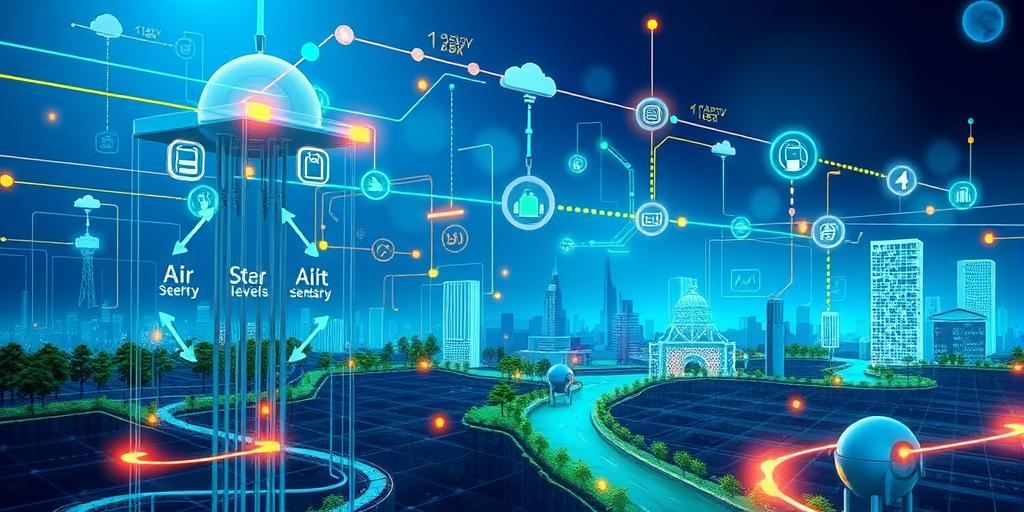Discover how IoT sensors are revolutionizing environmental monitoring! Prepare to be amazed by the incredible advancements in real-time data collection and analysis that are transforming our understanding of the planet. From detecting subtle shifts in air quality to pinpointing pollution sources with pinpoint accuracy, this technology is changing the game. Are you ready to explore the possibilities of this groundbreaking technology and how it’s leading the charge toward a more sustainable future? Let’s dive in!
Real-time Environmental Monitoring: The IoT Sensor Revolution
The Internet of Things (IoT) is rapidly changing how we monitor and manage our environment. No longer reliant on sporadic manual readings and delayed data, IoT sensors offer real-time data streams, allowing for immediate responses to environmental changes. This continuous monitoring is critical for addressing urgent environmental challenges. Imagine the power of instantly detecting air pollution spikes, or promptly identifying water contamination events – this is the transformative potential of IoT sensor networks. This technology isn’t just about raw data; it’s about actionable insights that lead to effective environmental management and protection.
Data Acquisition and Transmission
These sensors are incredibly diverse, measuring everything from temperature and humidity to particulate matter and gas concentrations. Data transmission methods vary depending on the sensor type and location, with options ranging from wired connections to wireless technologies like LoRaWAN and cellular networks. The beauty of this diversity is that it allows for customized monitoring solutions tailored to specific environmental needs, whether it’s tracking deforestation in remote rainforests or detecting leaks in underground water pipes.
Smart Environmental Management
The continuous flow of data from IoT sensors allows for far more sophisticated environmental modeling and predictive analysis. This facilitates proactive environmental management, enabling us to anticipate potential problems before they escalate into major environmental disasters. This also allows for more efficient resource allocation. For example, by accurately tracking water usage, water authorities can better manage water distribution systems, reducing waste and ensuring sufficient supply. This type of precision is key to effective and sustainable environmental management.
Applications Across Diverse Environments
The applications of IoT sensors in environmental monitoring are incredibly broad and versatile. From urban environments to remote wilderness areas, these sensors are transforming how we understand and interact with the natural world. Let’s explore some key application areas where this technology is making a significant impact:
Air Quality Monitoring
Air pollution is a major global concern. IoT sensors are deployed in urban areas and industrial sites to continuously monitor air quality parameters such as particulate matter (PM2.5 and PM10), ozone, carbon monoxide, and nitrogen oxides. This allows for the detection of pollution spikes, helping authorities to implement timely interventions to mitigate harmful effects. The immediate response enabled by this technology is what makes it so invaluable in protecting public health.
Water Quality Monitoring
Clean water is essential for life. IoT sensors are used to monitor water quality parameters, including pH, temperature, dissolved oxygen, and the presence of various pollutants. This real-time monitoring enables quick identification of contamination events, allowing for rapid responses to prevent wider contamination and protect water sources. Real-time data on water quality is also crucial for effective management and conservation of this precious resource.
Precision Agriculture
IoT sensors are revolutionizing agriculture by enabling precise monitoring of soil conditions, weather patterns, and crop health. This data allows for optimizing irrigation, fertilization, and pest control, leading to increased yields, reduced resource use, and more sustainable farming practices. This granular level of monitoring leads to more efficient and environmentally responsible agricultural techniques.
Challenges and Future Trends
While the potential of IoT sensors in environmental monitoring is immense, there are challenges to overcome. Data security, network reliability, and energy efficiency are key considerations. However, ongoing technological advancements are addressing these issues. We are seeing the development of more robust, energy-efficient sensors and more secure data transmission protocols. The integration of artificial intelligence (AI) and machine learning (ML) is also transforming the way environmental data is processed and interpreted, leading to more accurate predictions and informed decision-making. The future of environmental monitoring is bright, and the potential applications of IoT sensors are virtually limitless.
The widespread adoption of IoT sensors for environmental monitoring is critical for addressing the growing challenges facing our planet. From mitigating climate change to protecting biodiversity, these technologies offer powerful tools for creating a more sustainable and resilient future. Embrace this technological revolution and help shape a cleaner, healthier planet for generations to come! Join the movement today!




